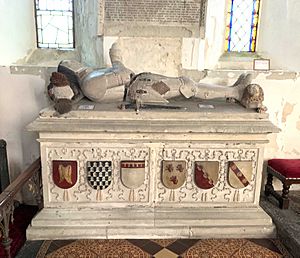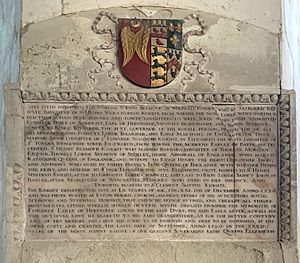St Mary's Church, Great Bedwyn facts for kids
Quick facts for kids St. Mary's Church, Great Bedwyn |
|
|---|---|

St. Mary's Church, Great Bedwyn; cross shaft in right foreground
|
|
| 51°22′37″N 1°36′09″W / 51.37685°N 1.60256°W | |
| Location | Great Bedwyn |
| Country | England |
| Denomination | Church of England |
| Architecture | |
| Heritage designation | Grade I listed |
| Style | Norman, Early English |
| Years built | 12th century |
| Administration | |
| Parish | Great Bedwyn |
| Deanery | Pewsey |
| Archdeaconry | Wilts |
| Diocese | Salisbury |
| Province | Canterbury |
The Church of Saint Mary the Virgin is a historic church in Great Bedwyn, England. It's a very important building, listed as Grade I listed. The church was mostly built in the 12th century in the Norman style. But even older parts, from the 10th century, are hidden underneath!
This church is special because it has a beautiful memorial for Sir John Seymour (1474–1536). He was the father of Jane Seymour, who became one of King Henry VIII's wives. He was also the grandfather of King Edward VI of England.
Contents
History of the Church
This church has very old roots, going back to the Anglo-Saxons. Around the year 905, the bishop of Winchester bought land in Great Bedwyn. He wanted to build a church there. Today, you can still find parts of that old Saxon church beneath the current building.
The Norman Era
In 1086, a big survey called the Domesday Book mentioned a church in Beduinde. A priest named Brictward looked after it. In 1091, the church's income was given to Salisbury Cathedral.
The 16th Century and a Royal Family Connection

Inside the church, there's a grand memorial for Sir John Seymour (1474–1536). He was a very important person. His daughter, Jane Seymour, married King Henry VIII. This made Sir John the grandfather of King Edward VI of England. He was also the father of Edward Seymour, 1st Duke of Somerset.
Sir John's monument was moved here in 1590 from another place. It's a stone tomb with his statue lying on top. The statue shows him in armor, with his hands together in prayer. His head rests on his helmet, and his feet are on a lion. A sword lies next to him.
A plaque above the tomb tells us about Sir John's family. He and his wife, Margerie, had six sons and four daughters. His famous children included Edward, Duke of Somerset, and Jane, who became Queen of England. Another son, Thomas, married Katherine Parr, who was King Henry VIII's last wife. Sir John passed away in 1536. His grandson, Edward, Earl of Hertford, moved his body to this church in 1590. He wanted to make sure his grandfather's memory lived on.
The 17th Century
Thomas Willis (1621–1675), a famous doctor and scientist from Oxford, was born in Great Bedwyn. He was baptized at this church in 1621.
The church also holds the elegant tomb of Frances Seymour, Duchess of Somerset (1599–1674). She was the daughter of Robert Devereux, 2nd Earl of Essex. He was a favorite of Queen Elizabeth I. Frances Seymour was the second wife of William Seymour, 2nd Duke of Somerset. They had seven children together.
Church Architecture
The church is shaped like a cross. It is built with flint stones and has special limestone details. The central tower is just the right height for the rest of the church.
The archways inside are from the late 12th century. The chancel, which is the area around the altar, was rebuilt and made longer in the late 13th century. The tower was built in the early 14th century. The parts of the church that stick out like arms (called transepts) were added around the same time. The windows at the ends of the transepts have a special curved design. The church was repaired and updated between 1853 and 1855 by architect Thomas Henry Wyatt. He added new roofs to the whole building.
Inside the Church
In the south transept, there are two old stone spaces for tombs from the early 14th century. In one of them, there is a stone statue of a knight. He has a shield and a drawn sword. People say this is Sir Adam de Stokke, who died in 1313. He is believed to have built the transepts.
In the 1850s, an old wooden screen from the 14th century was moved. It is now in the north transept. It was replaced by delicate iron railings. The architect Wyatt also designed a stone font (for baptisms) and a pulpit (where sermons are given). The original 15th-century font was moved to another church.
The church has six bells, all from the 17th century. The oldest bell was made in 1623. There is also a smaller bell, called a sanctus bell, made in 1741.
Churchyard Features
Outside the church, to the north-west, you can find the base and shaft of a 14th-century stone cross. It's a very old and important structure. On top of it, there's a sundial from the 17th century.
Near the church entrance, there is a war memorial from around 1920. It's a tall stone shaft with a beautifully carved cross. A three-sided wall lists the names of those who died in the First World War.
There are also several old chest tombs in the churchyard. These include tombs for the Tanner family and for Elizabeth Pinckney.
Church Management and Area
For a long time, from the late 11th century, the person in charge of Bedwyn church was called a "prebendary" from Salisbury. This person had special authority over Great Bedwyn, Little Bedwyn, and later Collingbourne Ducis parishes. This area was known as the "peculiar" of the Lord Warden of Savernake Forest. Even after the prebendary role ended in 1543, this special authority continued until 1847.
A vicarage, which is like a local church office, was set up in Bedwyn by 1316. The original parish area was very large. Over time, smaller chapels were built in places like East Grafton and Chisbury. Today, only the buildings at Little Bedwyn and Chisbury still stand. Little Bedwyn became its own separate parish in the 16th century. Later, in the 1800s, new churches were built, and parts of Great Bedwyn parish were moved to these new areas.
In 1982, the churches of Great Bedwyn, Little Bedwyn, and St. Katharine joined together. Today, the parish is part of the Savernake Team. This team includes eleven village parishes working together.
Gallery




